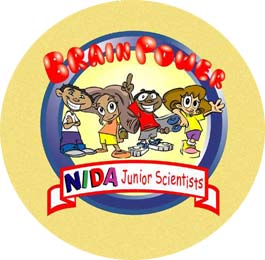Brain Power! The NIDA Junior Scientist Program takes students through a step-by-step exploration of science. The Web-based program describes what scientists do, the various functions of the brain and nervous system, and the effects of drugs on the nervous system and other parts of the . In-class science investigations, videotapes, and supplementary activities linked to other areas of the curriculum enable students with different learning styles and strengths to engage in the material. Brain Power! makes learning fun and sets young students on the road to a lifelong interest in science.
There are two Junior Scientist programs, one geared toward kindergarten and first-grade students, the other for second- and third-graders. The programs begin with the premise that a group of children has formed a Brain Power! Club that receives missions from NIDA to solve problems or scientific questions. To maneuver through these challenges, students turn to Corty, an animated brain that helps them ask appropriate questions and ultimately solve the problems. The programs are structured so that each of the five or six (depending on the program) modules builds on the knowledge gained in previous ones. Students first learn about scientists who study the brain. Subsequent topics follow logically and progress from meeting these scientists to learning about the brain and how to keep it healthy.
Brain Power! materials consist of a video, written materials for students, a parent newsletter, and a teacher's guide for each module. The program conforms to the National Science Education Standards, which encourage scientific exploration, development of hypotheses, and interactive group work and presentation. NIDA is developing materials for children in the fourth and fifth grades. The Brain Power! curriculum is available through NIDADrugPubs.
NIDA Junior Scientist Curricula Lay the Foundation for Substance Abuse Prevention
The modules in the Brain Power! curricula build on each other to instill essential knowledge and critical thinking skills. The second- and third-grade curriculum provides the following lesson plan:
- Module 1: Ooey Gooey! Making Sense of Scientific Inquiry, an introduction to the steps of scientific inquiry: to observe, hypothesize, experiment, and conclude.
- Module 2: Brains in a Box: What Your Brain Can Do, describes the functions of the four major parts of the brain—cerebral cortex, cerebellum, brain stem, and limbic system.
- Module 3: Sending and Receiving Messages, presents the basics of neurotransmission—the process of nerve cells communicating with each other.
- Module 4: Medicines and Drugs: What's Helpful, What's Harmful, teaches the differences between medicines and drugs.
- Module 5: The Science Behind Smoking, discusses nicotine, how it changes the brain, and how those changes may result in addiction to tobacco products.
- Module 6: What Drugs Really Do, tops off the curriculum with an embedded assessment for the entire program.

